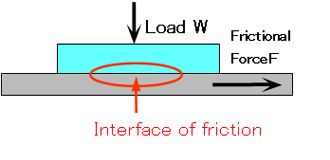Friction can be found at many places in our body, where two organs contact each other. For example:
- eye–eyelid
- joints
- surface of organs
- intima of a vessel-blood
- food–esophagus, etc.
These parts exhibit low frictional properties.
We do not feel any friction while moving our eyes. Knee joints never grind against each other even when one walks with heavy baggage. Blood flows smoothly in capillary vessels several micrometers in diameter. Food slips through alimentary tracts. All of these processes are attributed to low frictional properties.
Why is friction so low in these organs?
These organs containing a huge amount of water, blood, and lymph fluid, which are soft matter, or so-called GEL.
We could therefore speculate that the reason why friction is very low in the body is due to the soft and wet matters. In fact, an articular cartilage with extremely low friction has a water content of 75%–78%.
Friction of solids
riction between two sliding solid surfaces is generally represented as F = μW (Eq. 1) Here, F is the frictional force, W is the normal load, and μ is the frictional coefficient, which is specific to a particular material. In the case of a general solid surface, μ indicates a value of 0.1–1.0.

As shown in Eq. 1, it is known that the frictional force depends on only the normal load and not on the sliding velocity and contact area.
The wonder of gel friction
However, friction of gels shows different properties from friction of solids. The frictional force of some types of gels depends on the sliding velocity and contact area, and is not proportion to the normal load. Moreover, the μ values of gels, at 10-1–10-3, are much lower than those of solids.
Friction of gels with grafted surface
We discovered that even for the same chemical structure, hydrogels exhibit a much lower surface friction when their surface is modified with a grafted material. We obtained an extremely low friction gel with a μ value of 10-4.
μ=10-4means that if you load 100 kg onto a gel, the frictional force detected is no more than 10 gf. The surface of a gel is much more slippery than that of a solid. This value is much lower than that of our articular cartilage.

We are currently investigating the influence of graft length and density on friction.

